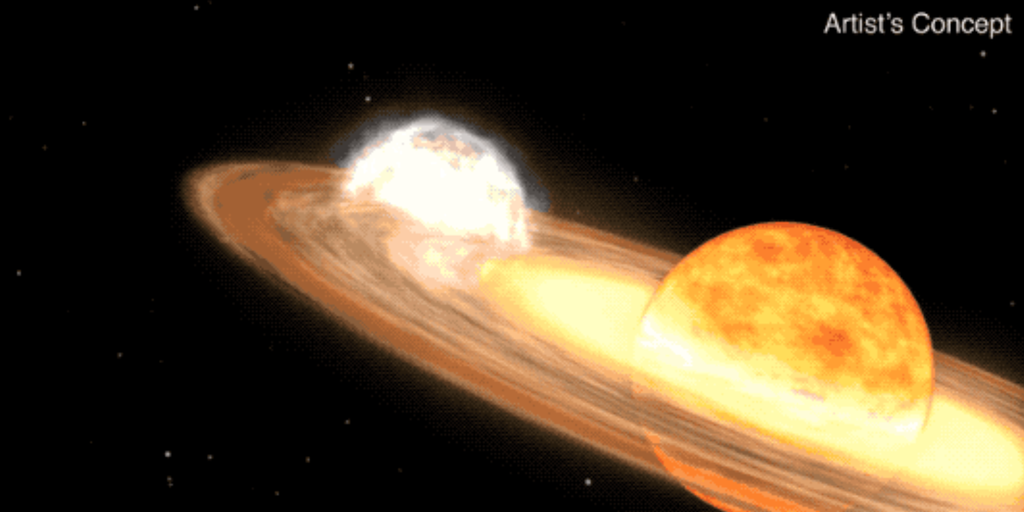Nova outburst 3,000 light years away will make new star visible to Earth
Frederick Walter, Galactic astronomer and professor at Stony Brook University, explains what a nova outburst is and why we’ll be able to see impacts from this one. Walter said the explosion will be visible for a few days to most on Earth.
Solar eclipse fans still riding their high from totality have something else to look forward to this year, which could also be a once-in-a-lifetime celestial event to witness.
A dance between two stars 3,000 light years away will culminate in a massive explosion so bright it will create the appearance of a “new” star in the night sky seen by the naked eye for several days and with a telescope for weeks.
Astronomers expect this Nova explosion within the binary star system known as T Coronae Borealis, or T CrB, to happen between now and September. The last time this explosion was observed was in 1946.
AMERICA’S TOTAL SOLAR ECLIPSE DAZZLES MILLIONS FROM TEXAS TO MAINE
Stellar astronomer Gerard Van Belle, with the Lowell Observatory in Arizona, said the science community is eager for this explosion to happen so they can use modern telescopes to study it.
“You have one star that’s getting old and again, kind of expanding and sloughing off its outer material, and that’s falling on the cinder of an even older star that all this left behind is this, this ember of a fire, really this thermonuclear core,” Van Belle said. “As material gets piled on top of it from its companion, it finally explodes.”
A red giant star and white dwarf orbit each other in this animation of a nova. The red giant is a large sphere in shades of red, orange, and white, with the side facing the white dwarf the lightest shades. The animation opens with the red giant on the right side of the screen, co-orbiting the white dwarf. When the red giant moves behind the white dwarf, a nova explosion on the white dwarf ignites, filling the screen with white light. After the light fades, a ball of ejected nova material is shown in pale orange. A small white spot remains after the fog of material clears, indicating that the white dwarf has survived the explosion. Credit: NASA’s Goddard Space Flight Center
One white dwarf star about the size of Earth and about as massive as the Sun is orbiting a red giant star, blowing off mass. Hydrogen falling onto the white dwarf accumulates over time, in this case, over about 80 years.
How do astronomers know the Nova explosion will happen?
Like meteor showers we see every year, people on Earth have been noting changes in the night sky for a very long time. With T CrB, this bright outburst was observed in the sky at least twice, 80 years apart, helping scientists determine it was a periodic event.
“We’re starting to get very long timelines in astronomy for some of these things. And so for this particular object, it was noticed in 1866 to brighten up. And then 80 years later, in 1946, it brightened up again,” Van Belle said. “It went from something that you can barely see with a pair of binoculars to something that you could walk outside and see with your own two eyes.”
Van Belle said that in the two previous explosions, the star brightened and dimmed over a two-year period, which has been happening again.
“It looks like it’s ready to pop off,” Van Belle said.
When will the T CrB explosion happen?
Unlike the solar eclipse or a meteor shower, astronomers can’t give us an exact time and date for the Nova explosion, but that could change over the next 80 years when the subsequent blast happens. Van Belle estimates that a future space telescope might make that possible.
NASA’S VOYAGER 1 SPACECRAFT RESUMES SENDING DATA TO EARTH FROM INTERSTELLAR SPACE AFTER 5-MONTH OUTAGE
“Can we get to a point where we can be able to say, you know, ‘It’ll be 5 o’clock on Thursday,’? But we’re not there yet,” Van Belle said.
Based on the brightening and dimming observed over the past two years, the best estimate is that the explosion will happen between now and September.
Technology in astronomy has seen significant advancements since the last time T CrB created an explosion visible on Earth. This will be the first time scientists can study this event using modern telescope arrays with extremely high resolution.
“Every telescope on Earth is probably going to at least do some observing of this particular event just to contribute to what is really kind of a once-in-a-lifetime event,” Van Belle said.
A telescope at Lowell in Flagstaff is already observing the object to establish a baseline. This will help astronomers determine when the explosion starts and measure its expansion as the fireball expands.
Van Belle said many astronomers have requested observation time for telescopes as they wait for the event.
“These are kind of interesting requests where you don’t really know where you need the time, but you can do this where you can ask for something in advance and basically say, ‘OK, we’re going to keep an eye out for this thing, and we’ll trigger this target of opportunity when it happens.’”
When it happens, array telescopes like those at Lowell Observatory can observe the explosion in detail. Van Belle said visitors to the observatory will also get to look through telescopes to see our new star in action.
Telescopes will see the increasing brightness and, eventually, the spot getting bigger as the fireball expands.
Van Belle said he is most interested in seeing the shape and direction of the explosion.
“Is it a big round thing? Is it lumpy on one side? Is it shooting a jet out in one direction? It’s probably going to start off as something that looks like a baseball but then ultimately look more like a barbell by the time it’s done,” he said. “It probably will be fairly directional in how it shoots the fireball off.”
Where can you see T CrB in the sky?
The outburst will appear as a new bright star in the Corona Borealis constellation.
A conceptual image of how to find Hercules and his mighty globular clusters in the sky created using a planetarium software. Credit: NASA (NASA)
Ahead of the Nova explosion, it’s a good idea to start looking at the Big Dipper in the night sky because Van Belle said it’s a helpful locator to find the new addition to the sky later this year.
NEW MONSTER MILKY WAY BLACK HOLE ONCE-IN-A-LIFETIME DISCOVERY, SCIENTISTS SAY
To find the new star, Van Belle said to follow the arm of the Big Dipper to the star Arcturus. During the summer, Arcturus can be found high in the sky soon after sunset.
“About halfway along that arc, just above that, you’ll see a smiley face, which is the northern crown, Corona Borealis. And this object is in Corona Borealis,” Van Belle said. “Just look for something new, roughly above where your knuckle is on the smiley face of Corona Borealis.”
According to NASA, the small, semicircular arc constellation is also near Bootes and Hercules.
When you look up and see something new, it indicates that the T CrB explosion has happened.
What happens after the Nova explosion is over?
During the week of the explosion, Van Belle said what we see as a “new star” in the sky is the material dumped onto the white dwarf acting as cinder burning off.
Once all the matter has burned off, the process starts again, and this dance in the T CrB system will continue well beyond our lifetimes.
HOW TO WATCH FOX WEATHER
“The irony here is the nova, the term that we use to call this thing, is Latin for new. But in fact, these are pretty old stars, and it’s just new because it’s new to us,” Van Belle said.
Van Belle said this explosive process could continue for about the next 2 million years throughout the life of the red giant star until it eventually dies and becomes a white dwarf.
“It’ll become something just like its companion,” Van Belle said. “And then they’ll just orbit each other for the rest of time.”

Dr. Sarah Adams is a scientist and science communicator who makes complex topics accessible to all. Her articles explore breakthroughs in various scientific disciplines, from space exploration to cutting-edge research.








